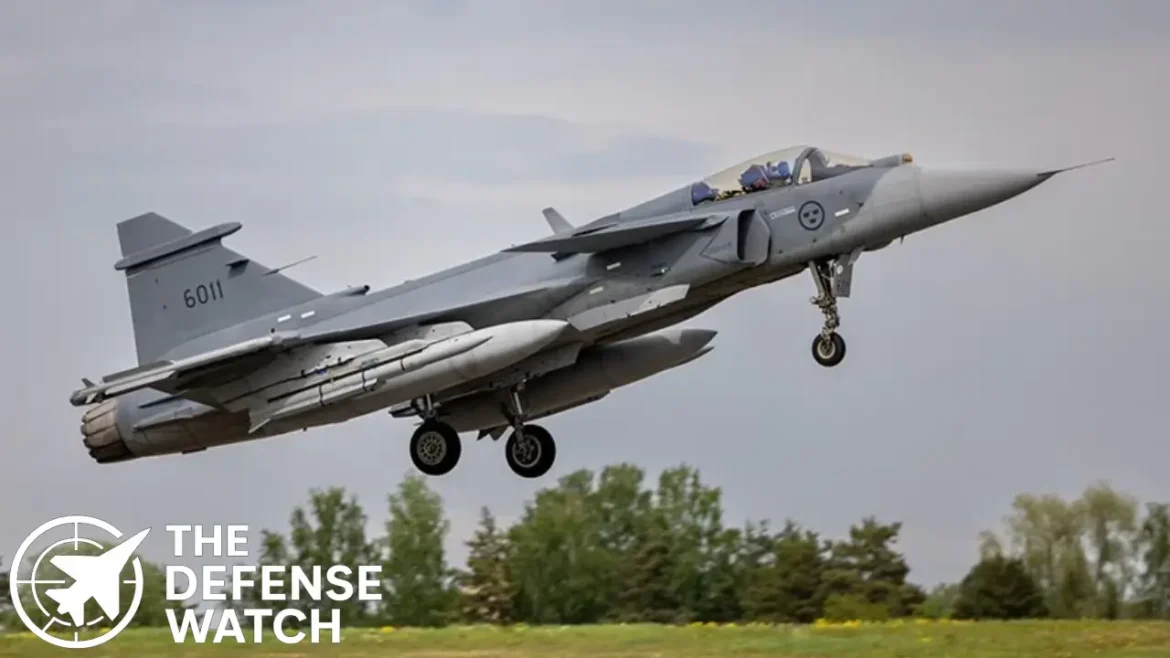On 20 October 2025, Swedish Air Force (SwAF) formally accepted into operational service the first of its ordered Saab JAS 39 Gripen E multirole fighter aircraft. The hand-over ceremony took place at the Skaraborg Wing (F 7) at Såtenäs air base, with officials from the Swedish Defence Materiel Administration (FMV), SwAF leadership and manufacturer Saab AB in attendance.
The aircraft marks the first new-build generation of this type for Sweden: although Brazil has previously received Gripen E jets, this is the first operational delivery to the country of origin.
Sweden has ordered 60 Gripen E units, though it will retain a portion of its older Gripen C/D fleet in parallel for a “relatively long period of time”.
-
Technological Advancements and Capabilities
The Gripen E represents what Swedish authorities describe as “in all essential respects a completely new aircraft”. Compared to the earlier C/D variants, major upgrades include:
- A more powerful engine: the GE F414-GE-39E afterburning turbofan, giving increased thrust.
- An AESA (active electronically scanned array) radar and IRST (infrared search and track) system, improving sensor suite and situational awareness.
- Ten hardpoints for weapon carriage (increased from earlier versions) and expanded fuel capacity (~30 % more) for longer range.
- Advanced electronic warfare/self-protection systems and an open mission system architecture enabling future upgrades.
SwAF noted that the platform is designed for operations in a “contested environment” — one where the airspace cannot be fully controlled. SwAF also emphasized that despite the upgrades, the Gripen E retains the “easy to fly and maneuver” qualities of the earlier variants, assisting pilot transition.
Strategic Context for Sweden
The induction of the Gripen E underpins Sweden’s broader shift in defense posture in the face of growing regional tensions, especially in the Baltic and Northern European theatre. With its 2024 accession to NATO and an intensified focus on territorial defence and air sovereignty, the Swedish Air Force is modernizing at pace.
In addition, Sweden is already studying the next generation of fighter systems, including options for manned/unmanned systems, with industrial concepts underway.Analysis: Meaning for U.S. Defense and Global Security
For U.S. defense observers, the Swedish induction of the Gripen E offers several meaningful insights:
1. Alliance air-power interoperability and burden-sharing
As Sweden integrates more capable combat aircraft alongside NATO operations, U.S. and allied forces benefit from stronger northern flank deterrence. Enhanced Swedish capabilities mean less burden on U.S. or allied assets in the Nordic/Baltic region.
2. Emergence of “4.5-generation” flexible fighters
The Gripen E is not stealth-fifth-generation, but represents a cost-effective, advanced air-superiority and multirole fighter with modern sensors and networked capabilities. For U.S. technology trend watchers, it underscores that smaller nations are opting for modern yet more affordable platforms rather than solely relying on U.S. fifth-generation jets.
3. Export dynamics and industrial base competition
With Sweden positioning Gripen E for export (recent orders by Brazil, Thailand, Colombia; LoI with Ukraine) U.S. defense firms and policymakers should monitor how this platform competes in global markets, influences supply-chain partnerships, and affects U.S. export strategy.
4. Contested-environment mindset in air operations
Sweden’s emphasis that the new jet is built for a “contested environment” speaks to broader shift in air warfare doctrine—dispersed operations, degraded control of airspace, contested ISR and EW. For U.S. planners, this reflects an environment increasingly shared by peer adversaries and allied air forces.Conclusion: What’s Next?
The delivery of the first Gripen E marks a significant step for Swedish air-power. Over the coming years Sweden will ramp production and integrate the fleet, concurrently operating the earlier C/D variants. On the export front, potential deals (notably with Ukraine) could elevate the Gripen line’s global footprint. For the U.S., Swedish capability enhancement bolsters allied deterrence, presents competitive industrial dynamics, and underscores evolving fighter-force design concepts that imply the next moves in air-systems architecture. Observers should watch subsequent Gripen E deliveries, how Sweden fields them operationally (possible Arctic/ Baltic scenarios), and how this intersects with U.S. air-power strategy through 2030.



11 comments
[…] decision to build its own fighter aircraft stemmed from a national policy of strategic independence. During the Cold War, Stockholm recognized […]
[…] growing military interest in hybrid aircraft aligns with broader trends in defense modernization. Traditional ISR and logistics aircraft — such as the P-8 Poseidon or C-130 Hercules — are […]
[…] the fighter’s relevance in extended conflicts, particularly as nations look for multi-role aircraft that deliver both strategic and tactical […]
[…] represents a shift toward rapid, automated response capabilities, aligning with broader defense modernization […]
[…] country relied on subsonic A-4AR Fightinghawks with limited modernization potential. The absence of modern fighters created a capability gap in territorial defense, air policing, and regional […]
[…] the past editions, ExpoDefensa has served as a key platform for defense modernization, technology transfer, regional cooperation, and the strengthening of local defense […]
[…] authorities say two separate incidents occurred “this week,” involving Chinese fighter aircraft locking fire-control radar onto Japanese […]
[…] reach, enabling stand-off attacks from safer distances. The missiles are compatible with Italian fighter aircraft including — but not limited to — the […]
[…] is in the middle of a major defense modernization push, seeking to upgrade its air-ground strike capabilities and ensure better interoperability with […]
[…] involving three NATO allies. With an estimated cost of up to 100 billion euros it is intended to deliver a future-proof fighter aircraft and associated technologies by around 2040. France’s Dassault Aviation is leading development of […]
[…] remain the core of US naval power projection. Each group typically includes a nuclear powered aircraft carrier, guided missile cruisers, destroyers, submarines, and a carrier air wing made up of […]